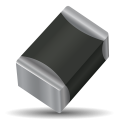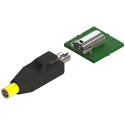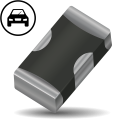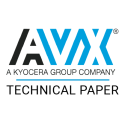The Principles of Varistor Selection Written By: Teddy Won Abstract: A varistor is an electronic component used to suppress transient voltages to protect electronic circuits. The behavior of varistors in a circuit is similar to TVS diodes, but they are entirely different in design, materials, and construction. There are many kinds of varistors on the market suitable for various applications, making choosing the right one to protect a given circuit challenging. KYOCERA AVX multilayer varistors, with a unique high-energy multilayer construction, provide state-of-the-art overvoltage circuit protection and protection from voltage transients caused by ESD, inductive switching, automotive-related transients, NEMP, lighting, etc. KYOCERA AVX multilayer varistors also provide EMI/RFI filtering in the off-state, which can replace the need for additional EMC
Circuit Protection
Passive Component Advancements for SPE Connectors and Circuit Protection Devices Written By: Daniel West | Julian Wilson Abstract: As Single Pair Ethernet (SPE) begins to roll out there will be a need for easy to implement, yet reliable wire-to-board interconnects. Purchasing finished cable and connector assemblies is not always economical or viable. However, it is also undesirable to work with time consuming and difficult to process connectors. Insulation Displacement Connectors (IDC) and Press-Fit technology (images below) require no crimping or soldering processes, and is easily converted to a streamlined process, while maintaining the versatility of cable lengths and positioning. In addition to reliable retention forces and gas tight seals afforded by the cold weld mechanism of IDC, signal integrity is
Advantages of Varistors and Their Applications in the Automotive Field Written By: George Zhang Abstract: Multilayer chip varistors (MLVs) are resistive elements comprising zinc oxide (Zn0) as the main component. In recent decades, they are being used for protection against surge voltage, noise, and transient voltages. Unlike conventional varistors, the maximum peak current and non-linear coefficients are large, and the resistance is very high below a threshold voltage, hardly allowing current to flow. However, when the voltage exceeds the threshold, the resistance drops abruptly and allows a large current to flow. Such properties make MLVs ideal as protective elements in a host of electrical and electronic applications, including automobiles
Miniature MLVs for Advanced Driver Assistance Systems Written By: Sudhama Dharmappa Abstract: Advanced Driver Assistance Systems (ADAS) have been used to enhance vehicle safety and performance long before the pursuit of self-driving cars. Since the moment electronic sensors were integrated into automotive designs, a variety of driver assistance techniques have been widely adopted, including anti-lock braking, traction control, and cruise control.
KYOCERA AVX Varistors for Automotive Ethernet Written By: Akihiro Kado | Michael Kirk Abstract: The ubiquity of high-performance sensor systems in modern automobiles (particularly electric and self-driving vehicles) has created immense pressure to develop automotive local area networking (LAN) solutions that offer high bandwidth, low latency, and low cost. Traditional wiring harnesses have become too heavy and complex to support these data and power needs.
The Frequency Response Effects of Internal Component Configuration on Multiple Ceramic Dielectric System Written By: S. Pala | R. Demcko | M. Berolini Abstract: The purpose of this paper is to discuss the frequency response effects of internal designs within ceramic systems. Those effects will be related to component performance parameters for devices used to suppress ESD and control EMI in high speed data lines, which are prone to be damaged by ESD. As communication speed increase, systems become more complicated and performance standards tighten, options to improve EMI/RFI performance becomes of great importance. Long term EMI performance and reliability are of particular importance in automotive, medical and aviation application sectors. A performance comparison will be made between single element
SMT Process Characteristics of AVX TransGuards Written By: Ron Demcko Abstract: TransGuards are uniquely suited for wide-scale usage in SMT applications. TransGuards exhibit many advantages when used in SMT assemblies. This paper is a general guideline aimed at familiarizing users with the characteristics of soldering multilayer SMT ZnO TransGuards.
LCD Driver Circuit EMI Filtering Options Written By: Ron Demcko Abstract: A review of EMI filter component options, comparing product performance, device characteristics and related factors (eg PCB board area, placement cost, etc.).
How to Choose the Correct Accu-Guard Fuse for Circuit Protection Written By: Irina Daynov | Barry Breen Abstract: The ACCU-GUARD is designed to meet the need of electronic circuits for a small, accurate surface mount fuse. This article presents design guidelines for achieving optimal protection of circuits with ACCU-GUARD. All major parameters are described including operating temperature, circuit voltage, fault current, steady state current and current pulses (Joule integral).
Capacitor Selection and EMI Filtering Written By: Jeffrey Cain | Steve Makl Abstract: MLCCs are an inexpensive, yet effective, method for reducing the noise on both power/ground systems and signal lines themselves. Choosing the proper capacitance value such that the impedance is minimized at the frequency of interest also makes a difference.
AVX Staticguard Performance Comparison to SOT-23 SMT Diodes Written By: Ron Demcko Abstract: AVX StaticGuard is designed to provide transient protection for MSI to VLSI CMOS circuitry. This article presents performance characteristics of low energy MLV transient voltage suppressors relative to low energy silicon diodes. All major parameters are described, including leakage current, clamping voltage, capacitance, peak current and repetitive strike performance. AVX StaticGuard is shown to have superior performance to SOT 23 diodes in transient suppression applications.
AVX EMI Solutions Written By: Ron Demcko | Chris Mello | Brian Ward Abstract: EMC compatibility is becoming a key design parameter for a most designers of electronic systems. This paper compares the efficiency and effectiveness of various EMI filter options available to designers. Integrated Thick Film LC T filters are shown to be a cost effective method to improve board level EMC performance while shrinking system design size and keeping costs minimized. A general recap of EMI sources is given as well as a brief recap of PCB layout and optimization rules.
A Multilayer Approach to Transient Voltage Supressors Written By: John Maxwell | Ning Chan | Allen Templeton Abstract: Improvements in integrated circuits have resulted in increased speed and increased ESD sensitivity. New systems require external protection more than ever before but advances in surface mount technology and product miniaturization place severe size constraints on protection components. Advances in ceramics now allow transient voltage suppressors to be built with multilayer structures resulting in improved electrical performance and in smaller sizes than comparable disc configurations. Clamping voltage and peak current performances approaching zener diode transient suppressors are achieved in the common 1206 (3.2 x 1.6mm) chip size, one third the size of SMT disc varistors or SMT zener diode supressors.





